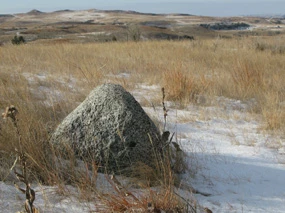|
Although glaciers are not to be found in Theodore Roosevelt National Park, the evidence of their geologically recent presence is throughout the park's landscape. During the Pleistocene Ice Age, tremendous ice sheets advanced from the north, redirecting the course of the Little Missouri River. Its new course caused the Little Missouri to carve more sharply into the soft sedimentary rock in the badlands, creating much of the broken topography found throughout the park. Direct evidence of the glaciers' recent presence is found in the North Unit. There, at the north rim of the the Little Missouri River Valley, the Pleistocene ice sheets reached the southernmost point of their advance. As the ice sheets stalled there, the conveyor belts of ice continued to transport rock from far away, depositing it at the foot of the glacier. Some of the rocks carried and deposited by the glaciers in this manner are called glacial erratics. These rocks are particularly noticeable because they are made of granite, an igneous rock found nowhere else in Theodore Roosevelt National Park's sedimentary rock layers. A pullout along the North Unit Scenic Drive highlights the presence of glacial erratics. 
Nathan King, NPS |
Last updated: April 10, 2015
